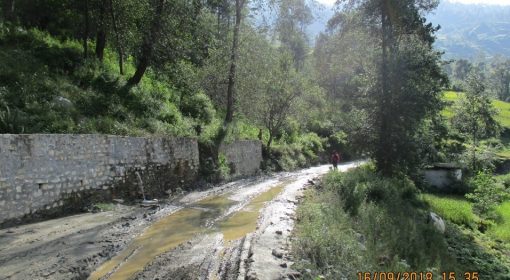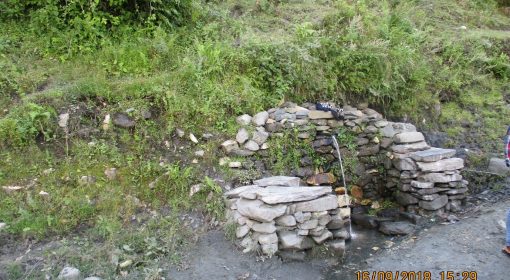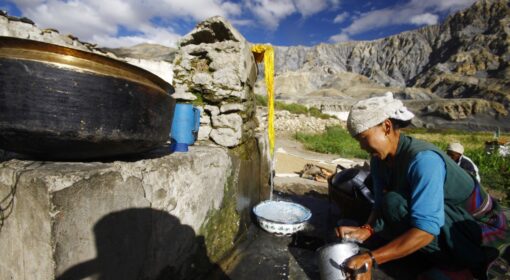by Anastasia Deligianni, Rojeena Dhoju, Saroj Bhujel, Saroj Yakami, Sonu Khanal and Madhav Dhakal
In Nepal’s Himalayan region, where the construction of roads often disrupts vital water systems, the Roadside Spring Protection (RoSPro) project offers a new way forward.
A collaboration between MetaMeta, the International Centre for Integrated Mountain Development (ICIMOD), and FutureWater, RoSPro aims to address two interconnected challenges: safeguarding critical mountain springs and enhancing road resilience.
Mountain springs are the lifeline of Nepal’s highlands, providing water for drinking, agriculture, and livestock. Yet, these essential resources are under threat. Expanding road networks often disrupt the delicate hydrogeological balance, causing springs to dry up. At the same time, unmanaged spring water damages roads, eroding their surfaces, weakening foundations, and driving up maintenance costs. The RoSPro project takes it on differently by reimagining roads as tools for protecting water resources rather than sources of harm.
By integrating road design with local hydrogeological knowledge and engaging local stakeholders and communities during all project phases, RoSPro preserves springs while strengthening infrastructure. The project follows a five-phase approach:
- Identifying Sites and Understanding the Context: Four springs impacted by roads in Dhankuta Municipality and Chhathar Jorpati Rural Municipality were identified, followed by socio-economic and hydrogeological surveys to understand local conditions.
- Co-Designing Solutions: Stakeholders collaborated to design interventions tailored to the spring outlets and recharge areas, blending civil engineering knowledge with nature-based solutions approach.
- Implementing Interventions: Solutions were implemented by mainly local communities in the four spring sites, addressing both water and road challenges. The interventions range from upstream measures such as trenches to increase recharge in the springshed area, spring protection and water collection structures to protect the source outlet and the road (e.g. perforated pipes with gabion walls for intakes, side- and cross-drains, live-check dams, collection chambers and reservoir tanks), and distribution system through pipes and tap stands to the water users.
- Monitoring and Cost-Benefit Analysis: Impacts of the interventions are now being monitored though household surveys and focus group discussions, alongside a Cost benefit analysis to assess their economic viability.
- Scaling with Digital Innovation: A “digital twin” tool is being developed to support scaling these interventions from pilot sites to basin-wide applications.
Early Impacts in Dhankuta District
A recent field visit to Dhankuta Municipality and Chhathar Jorpati Rural Municipality revealed encouraging progress:
- Roads are safer and more durable, with reduced water-related damage and maintainance costs.
- Households now have improved water access, saving time and supporting farm scale agriculture and livestock.
- Communities and local governments are more aware of the relationship between roads and springs and have the management and technical capacity to take up the interventions and replicate them.
- Some municipalities from Bagmati and Madhesh Province visited RoSPro sites and showed interest in replicating approach in their respective municipalities.
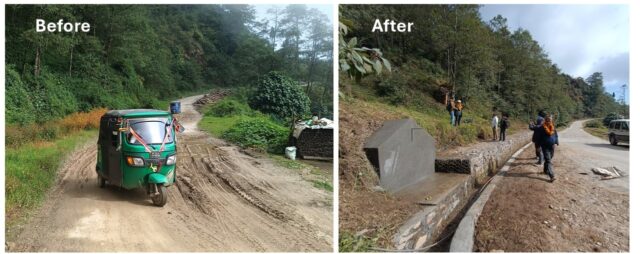
Below some site-specific lessons and achievements are listed – as shared by the local communities in each of the four sites:
| Site | Community Testimonies and Achievements |
| Chanchala Devi | The community shared about a challenge with a culvert that was misaligned, they needed 9 days, in which they discussed a lot with community and engineers on how to solve this. In the end they found a solution. And more importantly, they learned from this process on how to find a solution. It boosted their confidence that they have the technical capacity to do this themselves. |
| Bohje | Two newly discovered springs significantly improved water flow, saving women 3–4 hours daily. Reliable water supply has enhanced agricultural production, livestock management, and food security. The community is now aware of the interaction between springs and roads and have organized a system for operation and maintenance, to address any issues timely and effectively. |
| Dhoje Dharapaani | Road improvements have eliminated water-related damage, making roads safer and more accessible. Jagat, who collects biophysical data from the spring, notes: “The spring discharge after interventions has doubled, increasing from 15 lpm to 29 lpm compared to the same time in previous years.” Furthermore, water availability has been expanded to serve both Ward 5 and Ward 2, greatly assisting residents in their daily activities. Before the implementation of RoSPro, women had to carry vegetables to the spring to wash them. Now, with water available at home, they save a significant amount of time. |
| Keshari Kharka | Enhanced knowledge of spring management enabled residents to manage water resources effectively. A new pipe distribution system ensures a consistent supply, reducing water collection time by an hour and making water easily accessible at homes. The people of Keshari Kharka have taken the bull by its horns and are constructing roadside spring protection measures as they learned in the RoSPro co-design approach. A very quick replication! |
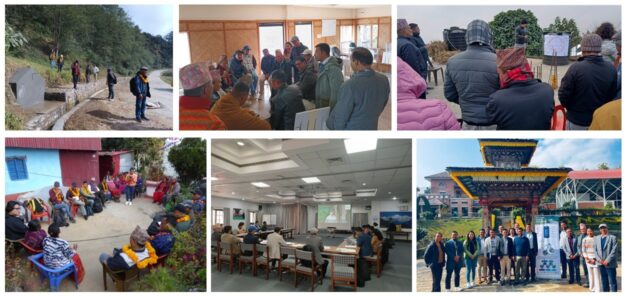
The project’s momentum extends beyond the field. Two workshops were organized to share lessons learned and chart the path forward:
- Regional Workshop: Engaged local municipalities, community representatives, and project stakeholders at district levels and stakeholder from national level i.e. Department of Local infrastructure Development (DoLID) to share experiences, address challenges, and plan next steps for sustaining the spring protection measures.
- National Workshop: Brought together national government departments on Roads, Water and Forestry, international NGOs, multilateral banks, private sector, and other stakeholders to discuss integrating the RoSPro approach into policies and strategies for road resilience, springshed management, agriculture, and livelihoods.
The workshops underscored broad interest in scaling RoSPro’s innovations across Nepal. With the cost-benefit analysis and digital dashboard nearing completion, the project aims to share these tools widely, enabling broader adoption and collaboration.
This is only the beginning. By working together, communities, governments, and development partners can expand the impact of RoSPro, creating sustainable solutions for Nepal’s Himalayan region and beyond.
